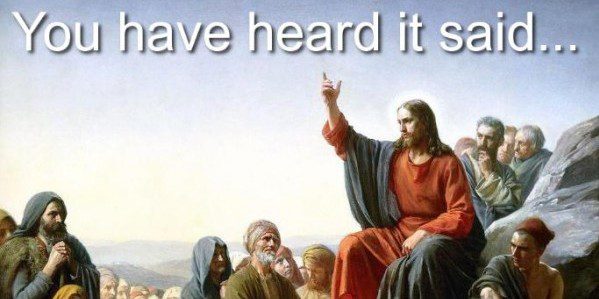Matthew’s “Sermon on the Mount” perplexes, bewilders, and confuses readers.

Jesus says it’s not enough not to murder; we shouldn’t even get angry? (5:22)
Jesus says it’s not enough not to commit adultery; we shouldn’t even look “with lust,” lest we face the prospect of eternal damnation? (5:28)
And then there’s the “turn the other cheek” deal (5:39) and the love not just your neighbor, but your enemy too, thing (5:43-44).
These teachings, while comprise a small, hard-hitting section (5:21-48) within the larger Sermon on the Mount are often called “antitheses,” because Jesus refers to a Torah teaching and intensifies or updates it.
The standards he puts forward seem so lofty, that many interpreters have suggested that maybe Jesus didn’t actually expect us to obey these commands (at least, not consistently). Maybe Jesus’ intention in the Sermon is that we’ll realize that we can’t do them, and so we’ll appeal to God’s grace and forgiveness.
That, by the way, (recognizing we can’t do them and appealing to God’s grace) has been a pretty standard approach in Protestant (Lutheran, especially) interpretation over many years. It was Kierkegaard’s approach to the Sermon. Kierkegaard wanted to uphold a high standard for “New Testament Christianity,” and get his Danish comrades (and the religious leadership of Denmark) to acknowledge they didn’t live up to it.
But that approach to the Sermon hardly does it justice. For one thing, Jesus seems pretty clear that the contents of the Sermon are things that his disciples are actually supposed to do. He insists he didn’t come to “abolish the law, but to fulfill it” (5:17), he urges that his disciples righteousness exceed that of the religious leaders (5:20), and he encourages them to be “perfect…as your heavenly Father is perfect” (5:48).
Many commentators point out that “perfect,” here means something more like “complete”; i.e. “do these things fully or completely.”
So, if the approach to the Sermon as “high ideals that can’t realistically be fulfilled” is not the best interpretation of the Sermon, then what is?
The approach that Glen Stassen and David Gushee advocated in their big book, Kingdom Ethics, gets us a lot further down the road toward what Jesus (or Matthew) was really after in the Sermon. They describe the problem here and offer a better interpretive approach:
We have already identified a tendency to accommodate to powers and authorities in the culture and therefore to compartmentalize and marginalize Jesus. A key step in that accommodation is to teach that the Sermon consists of hard teachings, ideals too high for us to reach up to; lovely sentiments but impossible for practical living. Once that step is taken, then it is easier to argue that we need some other ethic that we can practice—which almost always turns out to be an ethic that accepts the authority of some secular power and authority.
Thus a tradition has developed that the pattern of the Sermon is antitheses, in which Jesus prohibits anger, lust, divorce, oaths, resistance to evil and commands that we renounce all rights. Then people realize that they cannot avoid ever being angry and so on. So they say these are hard teachings, high ideals, very strenuous demands. They praise them for being so idealistic and then conclude that they cannot follow them in practice and adopt another ethic that comes from somewhere else. They compartmentalize Jesus’ teachings as meant for attitudes but not actions, or for repentance but not obedience, or for another future dispensation but not the present time, or merely as illustrations of general principles like love but not meant to be followed in particular. (133)
…And the result plays into the hands of secular interests that do not want the way of Jesus to interfere with their practices. Morality becomes secularized. Jesus gets marginalized or compartmentalized. The church’s ethic becomes vague and abstract.
So how, then, do Stassen and Gushee think we should read these “antitheses” in the Sermon on the Mount?
We propose a way to rescue the Sermon from the antitheses interpretation as perfectionistic prohibitions. It is deceptively simple, but it makes a huge difference in how the way of Jesus in the Sermon on the Mount is interpreted and will guide our interpretation throughout the rest of this book. The pattern of the Sermon is not twofold antitheses but threefold transforming initiatives. Therefore, the emphasis in interpretation is to be placed not on an alleged idealistic prohibition but on the realistic way of deliverance through the transforming initiatives.
They see each of the “antitheses” as comprising a threefold pattern of (1) a reference to “traditional righteousness”–as expressed in the Old Testament/Torah; (2) a Vicious Cycle (indicating how we get caught up in systems perpetuating sin and injustice when we follow our usual instincts); and (3) a Transforming Initiative, which is Jesus’ command (and suggestions) for breaking out of the Vicious Cycle and following a better way of living (a righteousness greater than the Pharisees).
Reading the Sermon this way, and the “antitheses” in particular, opens up the text in a different light and shows that these teachings are not “perfectionist prohibitions” which can hardly be expected to be followed, but are actually life-giving teachings that, if followed in community, would facilitate the kingdom of God on earth.
In a subsequent post, I’ll lay out an example of Stassen/Gushee’s “threefold initiative” to show how it works.
Stay in the Loop Like/follow Unsystematic Theology on Facebook















